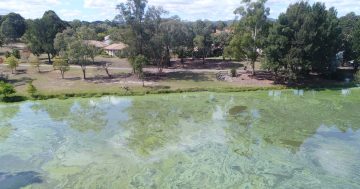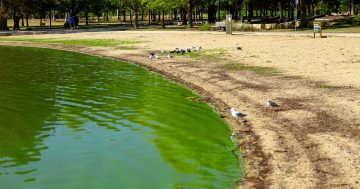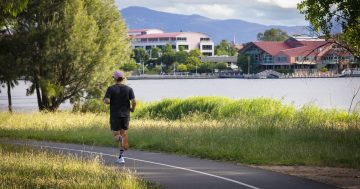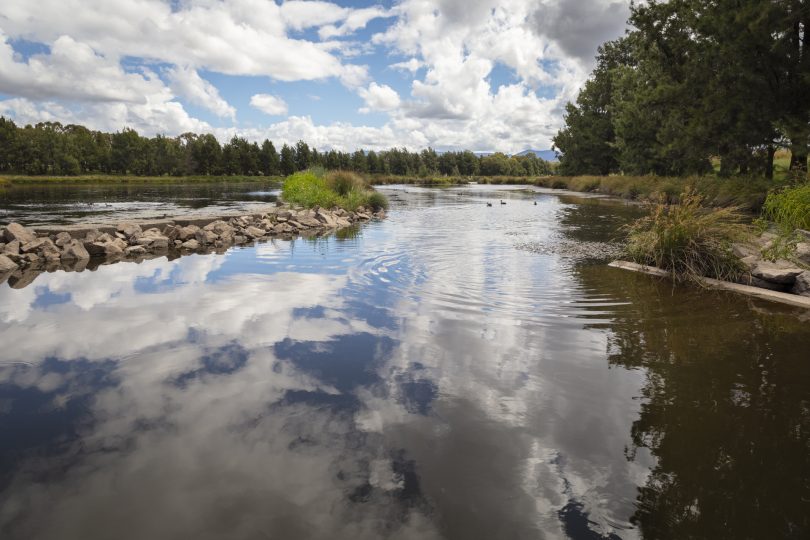
Research is underway to understand how toxic algal blooms in Canberra’s urban waterways such as Lake Tuggeranong can be prevented. Photo: Thomas Lucraft.
During Canberra’s long hot summer days, the lakes are a go-to attraction, but they’re hard to enjoy when they’re closed.
Scientific research is underway to understand how toxic algal blooms in Canberra’s urban waterways such as Lake Tuggeranong can be prevented.
In one study, the University of Canberra’s Rodney Urbrihien and Fiona Dyer have been monitoring inflow points, monitoring lake water quality and experimenting to understand a range of possible paths that could be considered to prevent toxic algal blooms.
Toxic algae needs a specific set of conditions to bloom and grow: water temperatures above 25 degrees Celsius, the formation of supportive thermal stratification conditions, total phosphorous levels exceeding 0.03 1 mg L -1 and then there is nitrogen. Toxic blue-green algae can draw nitrogen from the air if it isn’t present in the water.
Like any living thing, understanding how toxic blue-green algae (cyanobacteria) grows is the starting point to understanding what we can do to stop it.

Leaf litter contributes to the phosphorous load. Photo: Thomas Lucraft.
Lowering the temperature of a lake isn’t possible and, mixing an entire lake to disturb the stratification is extremely difficult in a lake the size of Lake Tuggeranong. Therefore, the key lies in the other vital ingredients. What can we do?
Given nitrogen can be accessed by toxic blue-green algae through the air, the focus has to turn to phosphorous, one of the first four ingredients that we can take away. Research has identified that surface phosphorous levels in Lake Tuggeranong were three times the total phosphorous concentrations needed for algal blooms.
Clearly, we have a big problem.
Work conducted by the University of Canberra continued to identify that the external nutrient load entering Lake Tuggeranong is high. Over the duration of a three-stage study, they calculated that 948 kg of phosphorus entered Lake Tuggeranong through three major inflows. Most of it entered the lake in high flows during rainfall events.
Phosphorous entering the lake occurs in two forms. Almost half is bioavailable. This form is called dissolved reactive phosphorus, and when it enters Lake Tuggeranong, it can start feeding toxic blue-green algal blooms straight away when the other three of the first four ingredients are present.
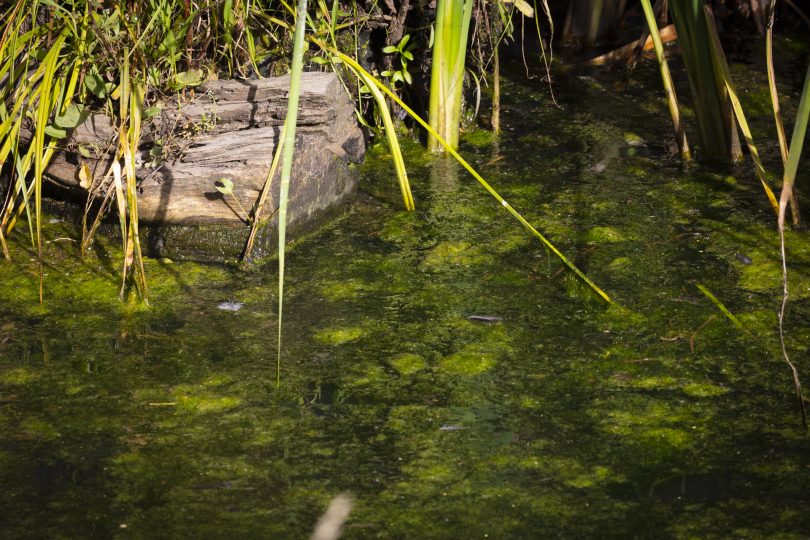
Algal bloom at Isabella Plains. Photo: Thomas Lucraft.
The remaining phosphorus entering the lake comes in with organic matter that can be stored for later conversion to dissolved reactive phosphorus. The organic matter settles, creating a nutrient-rich sediment layer. When conditions are ideal, including long dry periods and toxic algal blooms, phosphorous is released from the sediment layer, further fueling the fire.
Work completed by the University of Canberra team identified that 111 and 113 kg of phosphorus was released from sediment in the lake in the 2017/18 and 2018/19 seasons, respectively.
University of Canberra modelling suggests that approximately 80 to 100 kg of dissolved phosphorus is sufficient to maintain conditions conducive to algal outbreaks in Lake Tuggeranong. The good news is Canberrans can take steps to reduce the phosphorous load.
Actions households can take are:
- Collect leaves. You can put leaves in your green bin, make a leaf tower, drop them off at designated drop off points, give them to community gardens or ask a service provider to remove them for you. Check out Leaf Collective for options you can try. The added benefit of picking up leaves is that our gardens, paths, and streets look so much nicer when they are clear of leaves and removing leaves makes us bushfire ready.
- Start composting. Grass clippings and leaves combine perfectly, breaking down to deliver nutrients your garden needs to survive and thrive. Given the over-application of fertiliser is a key contributor of dissolved reactive phosphorus, this also means you avoid spending money applying chemicals that can run off and do harm.
- Create a rain garden. We can develop our gardens to stop excess stormwater runoff capturing organic matter in our garden beds.
- Install a rainwater tank. External loads during large rain events contribute to the highest concentration of dissolved nutrients in the lake. By using rainwater, you can make big savings on your water account.
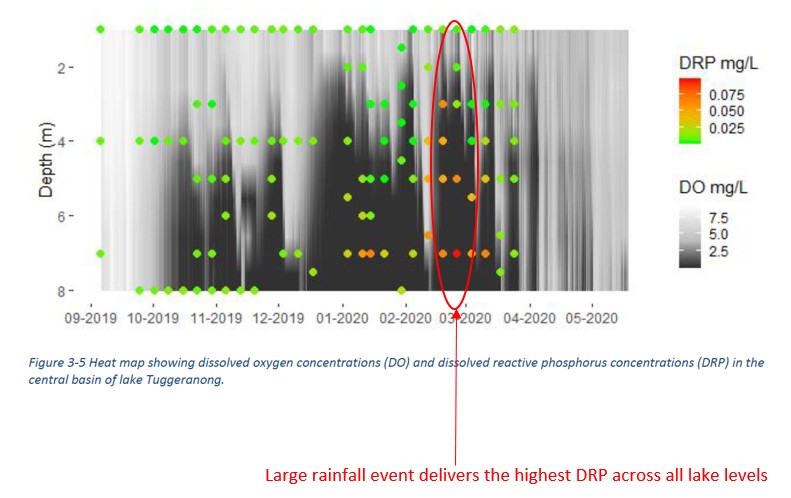
Heat map from a sample of the central basin of Lake Tuggeranong. Image: Griffith University.
There is no doubt there is too much phosphorous in Canberra waterways, such as Lake Tuggeranong. The sooner we all act to reduce phosphorous load, the quicker we can get back to enjoying open lakes year-round.
While science will continue to fit more missing pieces of the jigsaw puzzle together to further our understanding, we no longer need to sit back thinking someone else has got this.
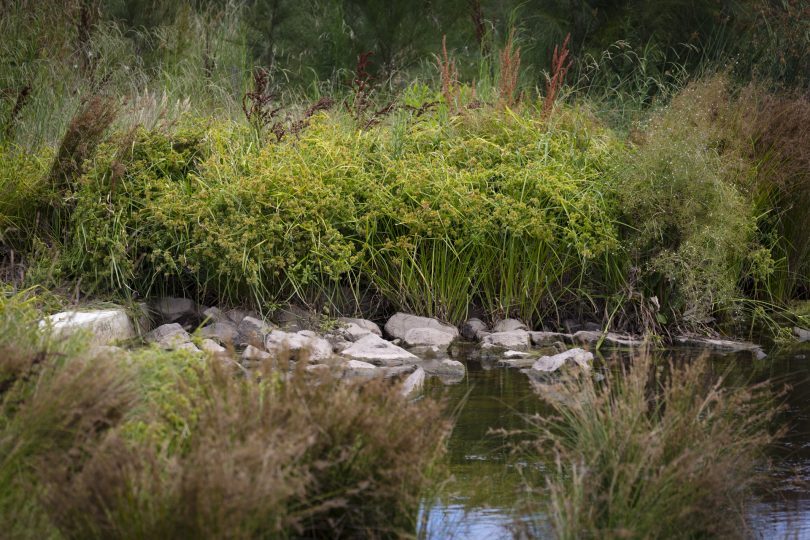
The sooner we all act to reduce phosphorous load, the quicker we can get back to enjoying open lakes year-round. Photo: Thomas Lucraft.
Urban landscapes are a key contributor to phosphorus loads. Every one of us needs to take action to lower the phosphorous in Lake Tuggeranong. Collective action will reduce the amount of phosphorous entering Canberra’s lakes.











